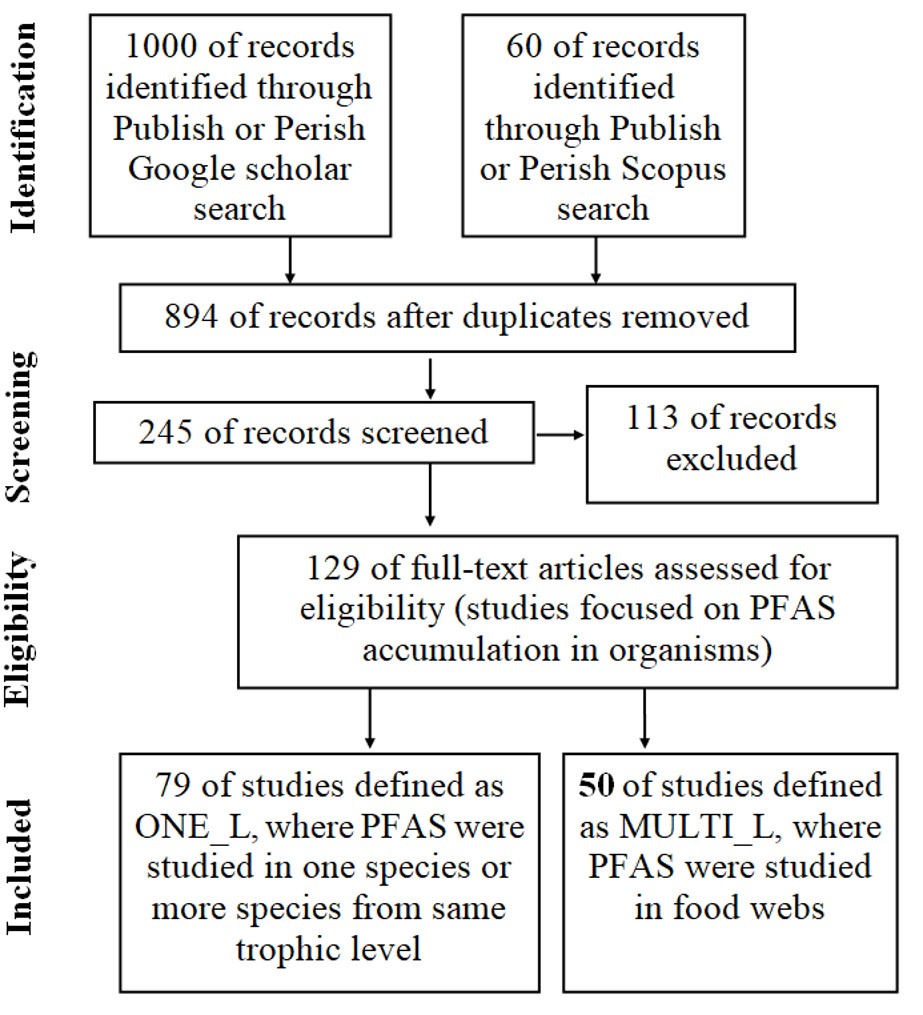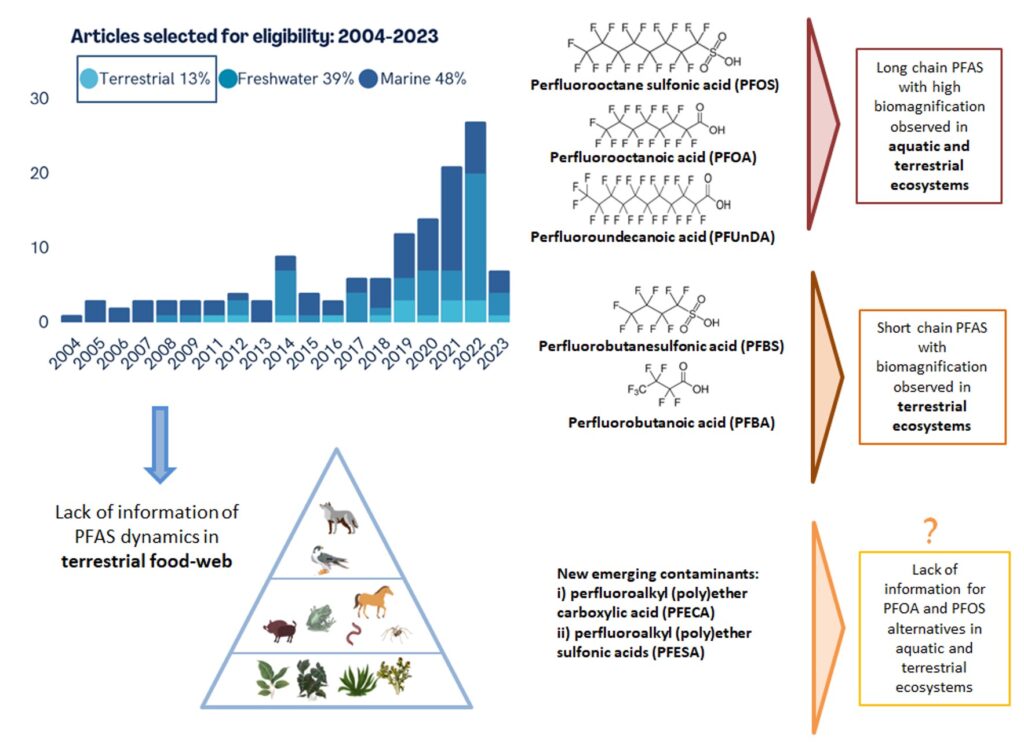Maria Teresa Guerra, Giorgio Mancinelli
Department of Biological and Environmental Science and Technologies – Di.S.Te.B.A. Centro Ecotekne – S.P. Lecce Monteroni, 73100 Lecce (LE) – Italy
Introduction
Per- and polyfluoroalkyl substances (PFAS) are a group of man-made chemicals that are known for their unique chemical properties and persistent nature 1,2. The major sources of PFAS have been identified in municipal waste disposal sites, landfills, wastewater treatment facilities, and biosolids 3. Nowadays, these substances can be found both in industrialized regions and remote areas 4,5. These chemicals are characterized by non-biodegradable behaviour and long-term persistence. With this work we aim to understand the current knowledge on PFAS accumulation or dilution effects observed across one or more trophic levels in freshwater, marine, and terrestrial environments. We made an effort to summarize the evidence regarding PFAS kinetics in food webs observed across different geographic areas and environments. In addition, we identified the principal PFAS congeners for which bioaccumulation/biodilution mechanisms have been determined. Not all PFAS congeners have been studied yet: we aim to understand the current state of the art about short-chain PFAS accumulation as well as PFAS replacements.
Methods
The literature analysis was conducted in accordance with the PRISMA guidelines 6. From the list of articles selected for eligibility, a screening was made to categorized the references into two main groups, the first including sources where: i) PFAS concentrations were assessed in a single species; ii) analysed species were located in different areas to assess the spatial distribution of PFAS and not to verify the trophic dynamics of the contaminants in the community, and iii) PFAS concentrations were analysed in several species belonging to the same trophic position; in the second group were included those studies where PFAS contents were determined in multiple species belonging to different trophic levels.

Figure 1. Workflow diagram: literature screening procedure.
Results and future research agenda
Following the research and screening procedure, a total of 129 articles were selected for eligibility from 2004 until April 2023. 79 ONE_L references (e.g., where PFAS have been studied in a single trophic level) were identified. The large majority of them (93%) were carried out in marine and freshwater ecosystems; the first was performed in 2004 and, subsequently, a continuous increase was observed. 50 MULTI_L investigations were identified (studies where PFAS dynamics studied among trophic levels). Similarly to the previous results, the large majority of them were carried out in aquatic ecosystems (90%), and only a small percentage of them were focused on terrestrial food webs. This might constitute an interpretative bias of the results, particularly for what concerns the bioaccumulation, biodilution and/or biomagnification mechanisms observed among trophic levels. Several long-chain PFAS showed bioaccumulation in both aquatic and terrestrial environments (Figure 2). Short-chain PFAS such as perfluorobutanesulfonic acid (PFBS) and perfluorobutanoic acid (PFBA), have been detected in the environment also enriching edible plants, however, there are still a few studies regarding their occurrence and/or bioaccumulation in whole food chains. The available literature suggests that short-chain PFAS such as PFBS do not show bioaccumulation in aquatic environments. Differently, they were characterized by bioaccumulation and biomagnification behaviors in terrestrial environments; even though the conclusion must be taken with caution given the scarce number of studies.

Figure 2. Synthesis of the main results from the literature screening procedure.
Our results showed the need to boost up ecotoxicological studies on PFAS alternatives in both aquatic and terrestrial ecosystems. SCENARIOS (Strategies for health protection, pollution Control and Elimination of Next generAtion RefractIve Organic chemicals from the Soil, vadose zone and water) H2020-funded project, aims to devise and demonstrate a comprehensive set of technological solutions to address PFAS detection, (bio)monitoring, long-term toxicity, risk assessment, pollution control and remediation. Among other tasks, SCENARIOS aims at clarifying the tropho-dynamics of a wide range of long- and short-chain PFAS congeners in contaminated terrestrial food webs, and to verify the potential transfer phenomena to neighbouring aquatic habitats. Thus, this project has the potential to boost up the current comprehension of PFAS trophodynamics in terrestrial food webs and to fill most of the knowledge voids highlighted by the present review synthesis.
References
1. Moody, C. A. & Field, J. A. Perfluorinated surfactants and the environmental implications of their use in fire-fighting foams. Environmental Science and Technology vol. 34 3864–3870 (2000).
2. Kissa, E. Fluorinated surfactants and repellents. vol. 97 (CRC Press, 2001).
3. Bolan, N. et al. Remediation of poly- and perfluoroalkyl substances (PFAS) contaminated soils – To mobilize or to immobilize or to degrade? J. Hazard. Mater. 401, (2021).
4. Giesy, J. P. & Kannan, K. Global distribution of perfluorooctane sulfonate in wildlife. Environ. Sci. Technol. 35, 1339–1342 (2001).
5. Müller, C. E. et al. Biomagnification of perfluorinated compounds in a remote terrestrial food chain: Lichen-Caribou-Wolf. Environ. Sci. Technol. 45, 8665–8673 (2011).
6. Moher, D., Liberati, A., Tetzlaff, J. & Altman, D. G. Preferred reporting items for systematic reviews and meta-analyses: the PRISMA statement. PLoS Med. 6, e1000097 (2009).